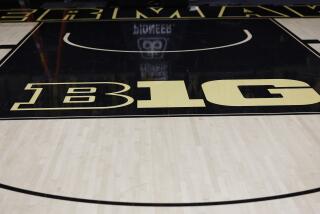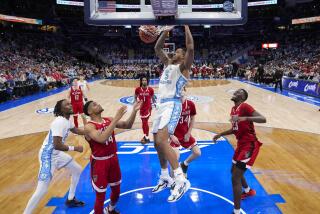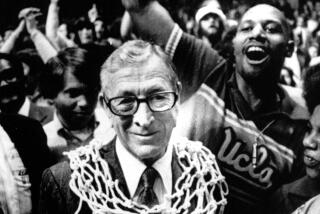COLLEGE BASKETBALL TOURNAMENT : This 50th Party Looks Like It Could Be Real Open House
- Share via
KANSAS CITY, Mo. — If Arnie Ferrin is right that “20 or 30” teams see themselves winning this year’s NCAA tournament, Jim Delaney shudders to think how many see themselves getting in.
“Let’s face it--some hopes are going to be shattered and some hearts are going to be broken,” said the Ohio Valley Commissioner and member of the nine-man selection committee. “If you don’t think so, you’re living in dreamland.”
Around 2:30 p.m. PST Sunday, committee chairman Ferrin will unveil on national television the 64-team bracket, in this year of rampant parity, for the richest-ever NCAA tournament.
Fans and officials of 64 schools will instantly begin checking flight schedules, figuring ways to get to the first-round site, among eight scattered around the country, their team is assigned to.
Sixty-four coaches will scramble for information and game films on their first-round foe. Some will be wearing big smiles and accepting congratulations. Others will complain--some mildly, some angrily--about where the committee has seeded and sent them.
Less visible, but no less ecstatic, will be the budget-planners at many marginal programs. Just getting an invite to this 50th annual tournament will bring in an estimated $230,700, say NCAA officials, and a ticket to the Final Four in Kansas City will be worth more than $1,150,000.
On the flip side of this equation will be those who are left out. Or, as former committee member Dave Hart used to say, “Somebody will go win the NIT and come back and tell us that that proves we don’t know what we’re talking about.”
Ferrin, Delaney and other tournament officials know there may be more of that than ever before. Twenty-seven spots go automatically to the winners of conference postseason tournaments. Three go to the regular season champions of the Ivy League, Big Ten and Mid-Continent Conference.
That leaves 34 at-large bids for the committee to distribute as it sees fit. For all practical purposes, this number is reduced by one every time a team that would not otherwise be considered gets hot and captures its league’s postseason tournament. And many observers figured heading into this weekend that the possibilities for postseason upsets were ripe.
“You’d have to say there is a much better chance for upsets, a much better chance that some at-large spots might be swallowed up by people who would not have gotten in otherwise,” said Tom Jernstedt, NCAA assistant executive director. “We usually have a few, but we’ve never been flooded with them.”
Ferrin, the University of Utah official who succeeded Dick Schultz this year as committee chairman, believes there are more teams with a legitimate shot at the the national championship than there ever were. He gets no argument from Jernstedt, the tournament director the past 16 years.
“Potentially, this could be the most difficult and challenging bracket we’ve ever put together,” Jernstedt said. “I can’t recall a year when it looked like the committee’s work in seeding the bracket and putting it together would be so difficult. It’s going to make the committee’s assignment tougher than ever. But on the other hand, it’s great. It’s another indication of the growth in the popularity of the game itself. There are more good players out there and more good teams than there ever have been.”
There’s also more money at stake.
Getting to the second round will net a team, in addition to travel and per diem expenses which the NCAA picks up, $461,511. Teams that lose in the third round will get $692,200. Falling one victory short of the Final Four will bring in $922,900, or almost six times as much as the regional finalists received in 1976.
“And that wasn’t that long ago,” said Delaney, a reserve guard on one of North Carolina’s Final Four teams in the early ‘70s. “It’s amazing how the sport has grown right before our eyes. In 1975, Junior Bridgeman was an All-American at Louisville when it lost to UCLA in the finals. A great player at a great program. You know how many times in his college career he appeared on national television? Once. This year, Middle Tennessee, Eastern Kentucky and Austin Peay have all played in games that were nationally televised.”
The committee, following a decades-old tradition, planned to begin meeting behind locked doors at a mid-town Kansas City hotel Friday evening. Surrounded by stacks of computer printouts and reports from regional advisory panels, the committee will emerge early Sunday evening with 64 teams divided into four 16-team regionals. Each regional is seeded 1 through 16, with the top seed meeting the 16th seed, No. 2 going against No. 15, etc. The committee can choose as many teams as it wishes from one conference and send a team to any regional it wishes.
In the recent past, this has meant an exodus of Eastern teams to the West in an effort to balance the bracket. But Ferrin has indicated that an upsurge in the number of quality teams among Western conferences may slow that trend this time.
Winners of the first and second-round games next weekend will flow into regional semifinals and finals March 25-27 at either Seattle, Birmingham, Pontiac, Mich., or East Rutherford, N.J. The championship game in Kansas City will be the night of April 4.
“We’ll spend all weekend pairing, comparing, separating and differentiating,” Delaney said. The committee pays little attention to total victories, concentrating instead on strength of schedule and a team’s road wins against quality opponents.
“Sixteen wins under some circumstances might be enough to get you in the tournament,” Delaney said. “Twenty-four wins under other circumstances might not be good enough. It’s a big responsible the commmittee has. It’s worrisome, it’s exciting, and we all love it.”
More to Read
Go beyond the scoreboard
Get the latest on L.A.'s teams in the daily Sports Report newsletter.
You may occasionally receive promotional content from the Los Angeles Times.










